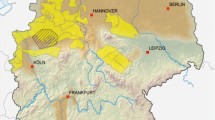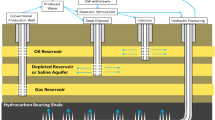Abstract
Hydraulic fracturing is a method used for the production of unconventional gas resources. Huge amounts of so-called fracturing fluid (10,000–20,000 m3) are injected into a gas reservoir to create fractures in solid rock formations, upon which mobilised methane fills the pore space and the fracturing fluid is withdrawn. Hydraulic fracturing may pose a threat to groundwater resources if fracturing fluid or brine can migrate through fault zones into shallow aquifers. Diffuse methane emissions from the gas reservoir may not only contaminate shallow groundwater aquifers, but also escape into the atmosphere where methane acts as a greenhouse gas. The working group “Risks in the Geological System” as part of ExxonMobil’s hydrofracking dialogue and information dissemination processes was tasked with the assessment of possible hazards posed by migrating fluids as a result of hydraulic fracturing activities. In this work, several flow paths for fracturing fluid, brine and methane are identified and scenarios are set up to qualitatively estimate under what circumstances these fluids would leak into shallower layers. The parametrisation for potential hydraulic fracturing sites in North Rhine-Westphalia and Lower Saxony (both in Germany) is derived from literature using upper and lower bounds of hydraulic parameters. The results show that a significant fluid migration is only possible if a combination of several conservative assumptions is met by a scenario.



















Similar content being viewed by others
References
Bachu S, Bennion B (2007) Effects of in-situ conditions on relative permeability characteristics of CO2-brine systems. Environ Geol 54(8):1707–1722. doi:10.1007/s00254-007-0946-9
Batzle M, Wang Z (1992) Seismic properties of pore fluids. Geophys 57(11):1396. doi:10.1190/1.1443207
Brooks RH, Corey AT (1964) Hydraulic properties of porous media. In: Hydrology Papers, vol 3. Colorado State University, Fort Collins
Daubert TE, Danner RP (1989) Physical and thermodynamic properties of pure chemicals: data compilation. Hemisphere Publishing
Du C, Zhang X, Melton B, Fullilove D, Suliman ET, Gowelly S, Grant D, Calvez J (2009) A workflow for integrated Barnett Shale gas reservoir modeling and simulation. In: Proceedings of Latin America and the Caribbean Pet engineering conference. Society of Petroleum Engineers, p 112. doi:10.2118/122934-MS
Duan Z, Møller N, Weare JH (1992a) An equation of state for the CH4-CO2-H2O system: I. Pure systems from 0 to 1000C and 0 to 8000 bar. Geochimica et Cosmochimica Acta 56(7):2605–2617. doi:10.1016/0016-7037(92)90347-L
Duan Z, Møller N, Weare JH (1992b) An equation of state for the CH4-CO2-H2O system: II. Mixtures from 50 to 1000C and 0 to 1000 bar. Geochimica et Cosmochimica Acta 56(7):2619–2631. doi:10.1016/0016-7037(92)90348-M
Ewen C, Borchardt D, Richter S, Hammerbacher R (2012) Hydrofracking risk assessment. http://dialog-erdgasundfrac.de/risikostudie-fracking
Flemisch B, Darcis M, Erbertseder K, Faigle B, Mosthaf K, Müthing S, Nuske P, Tatomir A, Wolf M, Helmig R (2011) DuMux: DUNE for multi-phase, component, scale, physics,... flow and transport in porous media. Adv Water Resour 34(9):1102–1112. doi:10.1016/j.advwatres.2011.03.007
Fuller E, Schettler P, Giddings J (1966) New method for prediction of binary gas phase diffusion coefficients. Ind Eng Chem 58(5):18–27
Gordalla B, Ewers U, Frimmel FH (2013) Hydraulic fracturing—a toxicological threat for groundwater and drinking water? Environ. Earth Sci (under revision this issue)
Helmig R (1997) Multiphase flow and transport processes in the subsurface: a contribution to the modeling of hydrosystems. Springer, Berlin
Kissinger A, Helmig R, Ebigbo A (2012) Modellierung des transports von Frack-Fluiden, Lagerstttenwasser und Methan. 14. In: Aachener Altlasten- und Bergschadenkundliches Kolloquium, Heft 130 der Schriftenreihe der GDMB, pp 21–31
King GE (2012) SPE 152596 Hydraulic fracturing 101 : what every representative, environmentalist, regulator, reporter, investor, University researcher, neighbor and engineer should know about estimating frac risk and improving frac performance in unconventional gas. In: SPE hydraul fracturing technol conference. The Woodlands, Texas, USA, pp 1–80
Koike K, Liu C, Sanga T (2011) Incorporation of fracture directions into 3D geostatistical methods for a rock fracture system. Environ Earth Sci 66(5):1403–1414 doi:10.1007/s12665-011-1350-z
Kunz E (1994) Gasinhalt der Nebengesteine des Steinkohlebergbaus. Glückauf Forschungsheft 4(5):106–110
Lange T, Sauter M, Heitfeld M, Schetelig K, Jahnke W, Kissinger A, Helmig R, Ebigbo A, Class H (2013) Hydraulic fracturing in unconventional gas reservoirs—risks in the geological system, part 1. Environ Earth Sci (this issue)
Myers T (2012) Potential contaminant pathways from hydraulically fractured shale to aquifers. Ground water, pp 1–11. doi:10.1111/j.1745-6584.2012.00933.x
Reid R, Prausnitz E, Poling B (1988) The properties fo gases and liquids, 4th edn. McGraw-Hill, New York
Riedl J, Faetsch S, Schmitt-Jansen M, Altenburger R (2013) Ecotoxicological assessment of fracturing fluids using a component-based mixture approach. Environ Earth Sci. doi:10.1007/s12665-013-2320-4
Sauter M, Helmig R, Schetelig K, Brosig K, Lange T, Kissinger A, Ebigbo A, Heitfeld M, Klünker J, Wiebke J, Paape B (2012) Abschätzung der Auswirkungen von Fracking-Manahmen auf das oberflächennahe Grundwasser Inhaltsverzeicha nis Geologisch-hydrogeologischer Rahmen. Technical report. http://dialogerdgasundfrac.de/gutachten, 122 p
Tatomir AB, Szymkiewicz A, Class H, Helmig R (2011) Modeling two phase flow in large scale fractured porous media with an extended multiple interacting continua method. CMES 77(2):81–112
Tenzer H, Park C, Kolditz O, McDermott CI (2010) Application of the geomechanical facies approach and comparison of exploration and evaluation methods used at Soultz-sous-Forts (France) and Spa Urach (Germany) geothermal sites. Environ Earth Sci 61(4):853–880. doi:10.1007/s12665-009-0403-z
U.S. Energy Information Administration (2011) Review of emerging shale gas and shale oil plays. Technical report, U.S. Energy Iinformation Administration, Washington, DC
Uth H-J (2012) Gutachten zur technischen Sicherheit von Anlagen und Verfahren zur Erkundung und Förderung von Erdgas aus nichtkonventionellen Lagerstätten. http://dialog-erdgasundfrac.de/gutachten, 113 p
Walter L, Binning PJ, Oladyshkin S, Flemisch B, Class H (2012) Brine migration resulting from CO2 injection into saline aquifers: an approach to risk estimation including various levels of uncertainty. Int J Greenh Gas Control 9:495–506. doi:10.1016/j.ijggc.2012.05.004
Acknowledgments
The authors would like to thank Christoph Ewen and Ruth Hammerbacher along with their teams for the conceptual development and organisation of the hydrofracking dialogue and information dissemination processes. The authors would also like to express their sincere thanks to Michael A. Celia for reviewing the work of the group “Risks in the Geological System” as well as an anonymous reviewer for many constructive suggestions which helped improve the quality of this article.
Author information
Authors and Affiliations
Corresponding author
Electronic supplementary material
Below is the link to the electronic supplementary material.
Rights and permissions
About this article
Cite this article
Kissinger, A., Helmig, R., Ebigbo, A. et al. Hydraulic fracturing in unconventional gas reservoirs: risks in the geological system, part 2. Environ Earth Sci 70, 3855–3873 (2013). https://doi.org/10.1007/s12665-013-2578-6
Received:
Accepted:
Published:
Issue Date:
DOI: https://doi.org/10.1007/s12665-013-2578-6




